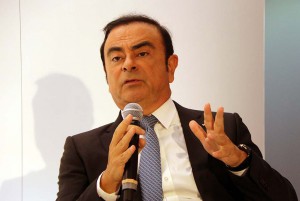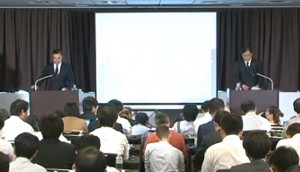
Renault-Nissan CEO Carlos Ghosn said the acquisition of Mitsubishi could make his company tops in auto sales globally next year.
For much of the last decade, Toyota Motor Co. has won the global sales sweepstakes, though it is being chased by an increasingly aggressive Volkswagen AG. But now, a wildcard has entered the race, and CEO Carlos Ghosn said it’s a strong possibility that his Renault-Nissan Alliance could soon brush outside those two rivals.
The Euro-Japanese partnership lagged more than a million units behind its two rivals last year, so it would need a turbo-boost to take the lead. And that just might happen in 2017 as the Nissan side of the alliance completes its planned acquisition of struggling Japanese automaker Mitsubishi.
Would that push the Renault-Nissan Alliance over the top? “Yes,” Ghosn responded to a question during a Paris Motor Show news conference. “We may become number one, even thought that is not our objective.”
For years, General Motors held global sales leadership, but it ceded that lead as it plunged towards its 2009 bankruptcy, regaining the crown only briefly when Japanese automakers, in general, were crippled by a devastating earthquake and tsunami.
Toyota topped the charts, again, in 2015, the Japanese maker and its partners selling 10.15 million vehicles worldwide compared to number two Volkswagen at 9.81 million.
But this year’s results are up in the air. Despite its diesel emissions testing scandal – which has hammered demand in the U.S. market – VW managed to surge into the lead for the first half of 2016, selling 5.116 million cars, trucks and crossovers a worldwide increase of 1.5%. By comparison, Toyota saw its sales dip by 0.6%, to 4.992 million.
(Infiniti drives into Paris with two new models and new powerplants. Click Here for details.)
GM was a weak third, with first half volume of 4.76 million. And while it didn’t release formal numbers, Renault-Nissan was thought to hold the number four spot it captured for all of 2015.
But the Alliance could be setting itself for a big surge next year, perhaps reaching volumes of as much as 10.5 million, according to Ghosn. The key would be the takeover of Mitsubishi, which is now in the works.
Nissan and the smaller maker – which sold 1.2 million vehicles worldwide in 2015 – have long worked together. Mitsubishi builds a number of microcars for sale under the Nissan nameplate, for one thing.
(Click Here for details about Renault-Nissan’s new deal with Microsoft.)
Ironically, that’s where it got in trouble when the bigger maker discovered some serious discrepancies in the fuel economy of such pint-sized models as the Roox. Mitsubishi subsequently admitted rigging its mileage testing for the past 25 years. The disclosure devastated both its sales and stock price, threatening to plunge Mitsubishi into bankruptcy.
In May, Ghosn announced plans to acquire a controlling, 34% stake in the smaller maker for a relative bargain price of $2.2 billion. The deal is currently in due disclosure, but the CEO said he expects to complete the move by year-end. That would mean Mitsubishi sales will be added into those of the broader group in 2016 – alongside other partners controlled by the Renault-Nissan Alliance, such as Russia’s Dacia.
The group figures do not include sales by Daimler AG, however. While the German maker has an expanding line-up of joint ventures with Renault-Nissan, they operate on an ad hoc basis, with no formal financial cross-links between the companies. Nonetheless, that alliance has, Ghosn claims, helped drive down costs which, in the process, have helped boost Renault-Nissan sales.
(Nissan wants to redefine mobility. Click Here to see how.)
Despite the possibility of taking over the global sales crown, Ghosn told reporters, “There is no race” to be number one, just a push to be close to whomever is on top. “What matters is not whether we are number one, two or three, but whether the (gap) is small.” That means production costs are similar, and removes one key advantage of whichever company actually is on top.

